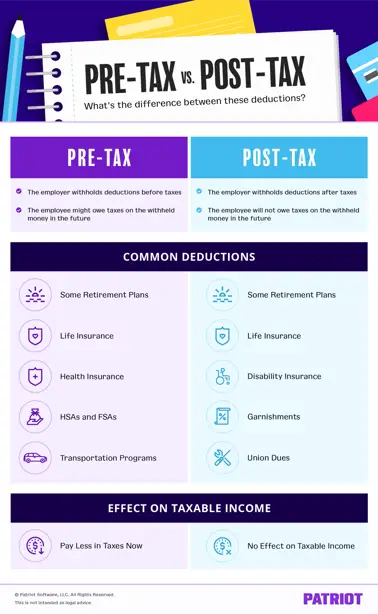Demystifying Post-Tax Deductions: Understanding Your Paycheck
Managing payroll involves more than simply distributing paychecks based on hours worked. It necessitates meticulous deduction processing, encompassing taxes, pre-tax deductions, and post-tax deductions from payroll. To explore what is post-tax deduction, as well as to gain insights into frequently withheld post-tax deductions, delve into the informative article provided by Aniday.

What is post tax deduction?
A post-tax deduction signifies an amount extracted from an employee's paycheck subsequent to the deduction of all relevant taxes. Unlike pre-tax deductions, which diminish an employee's taxable income by being subtracted from gross income before tax calculations, post-tax deductions operate differently.
Examples of post-tax deductions encompass contributions to retirement plan accounts, union dues, and certain insurance premiums. In contrast to their pre-tax counterparts, these funds can typically be accessed without incurring additional tax obligations.
Human resources (HR) professionals bear the responsibility of accurately handling and communicating the implications of post-tax deductions. These deductions directly influence net income, employee contentment, and financial planning.
Effective management is an essential element of responsible payroll administration, necessitating a thorough understanding to ensure adherence to regulations and promote transparent interactions between employers and employees.
Distinguishing Pre-tax from Post-tax Deductions
Pre-tax deductions are subtracted from employee wages before tax withholding, effectively reducing the taxable income for the employee
Conversely, post-tax deductions are withheld from employee wages after taxes have been deducted and do not impact the employee's taxable income.
Whether a benefit is considered pre-tax or post-tax is usually decided by the benefit policy. Sometimes, you or the employee can choose between pre-tax and post-tax deductions. Let's explore each type of deduction more closely.

Common examples of Post-tax Deductions
As previously mentioned, post-tax deductions refer to the amounts subtracted from an employee's paycheck after all applicable taxes have been calculated and deducted from their gross salary. These deductions encompass a diverse range of aspects relating to an employee's personal, financial, and occupational interests.
Retirement savings account
A typical post-tax deduction is retirement savings. Money you add to this account doesn't reduce your taxable income for the current year. The benefit? When you withdraw the money for retirement, you won't pay taxes on the earnings or the withdrawn amount.
Insurance premiums
The way insurance works can be different. Sometimes, the money you pay for life, disability, and certain health insurance is taken out after taxes are already taken from your paycheck. But remember, this depends on the rules of the insurance plan and the tax laws that apply.

Union dues
Union dues serve as a prevalent example of post-tax deductions. When employees are affiliated with a labor union, these dues are deducted from their earnings following the completion of tax calculations. In this process, union members witness the subtraction of their dues after the accurate assessment of their tax obligations has been carried out.
Charity donations
After-tax deductions can include things like giving money to charities from your paycheck, repaying personal loans, and taking out money for things like child support or unpaid taxes. Each of these deductions has its own tax rules, advantages, and possible disadvantages.
Garnishments
In cases where an employee has unresolved debts, you may receive an official directive to deduct a garnishment from their paycheck. This directive typically takes the form of an income withholding order.
Debts that might trigger garnishment encompass outstanding obligations such as:
-
Taxes
-
Child support payments
-
Student loans
-
Credit card debts
-
Medical bills
Unlike other post-tax deductions, garnishments are not voluntary. They are considered involuntary deductions, and you must legally withhold these amounts from an employee's wages as instructed.

Example on how post-tax deduction is calculated
Caroline’s gross wages are 1,000 dollars. Her usual taxes are 7.65 percent, her additional taxes total 75 dollars, and her retirement savings account after-tax deduction is 4 percent.
Here’s Caroline’s take-home pay once taxes, which includes Social Security and Medicare taxes, and other incomes taxes have been withheld:
-
Multiply the gross pay by the usual taxes percentage: $1,000.00 X 0.0765 = $76.50
-
Calculate the deduction amount by multiplying the gross pay by the deduction percentage: $1,000.00 X 0.04 = $40.00.
-
Subtract the standard taxes from the initial gross pay: $1,000.00 - $76.50 = $923.50.
-
Then, subtract the additional taxes from this new total: $923.50 - $75.00 = $848.50.
We’ll pause here to point out that $848.50 would be what Caroline gets paid, if not for her retirement savings account after-tax deduction, which hasn’t come out yet. That comes next:
-
Subtract the deduction amount from the new total: $848.50 - $40.00 = $808.50
Caroline’s take-home pay equals $808.50.
Conclusion
Running payroll goes beyond just handing out paychecks based on worked hours. It involves careful deduction management, which includes dealing with taxes, pre-tax deductions, and post-tax deductions from payroll. We hope that you have gained a brief understanding of the differences between post-tax and pre-tax deductions and get a better grasp of what is post tax deduction with the informative article from Aniday.
Aniday's HR Services
Headhunting Service
Find and recruit quality candidates in just 1 week! Supported by 40,000 experienced headhunters in IT, Finance, Marketing… capable of recruiting in any region.
Headhunting Service ➔Employer of Record (EOR) Service
On behalf of your business, we recruit employees and handle payroll without the need to establish a company in markets such as Vietnam, Singapore, Malaysia, India, Indonesia…
Employer of Record (EOR) Service ➔